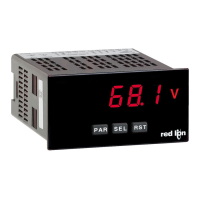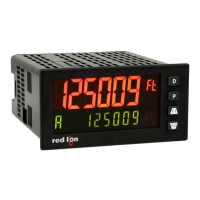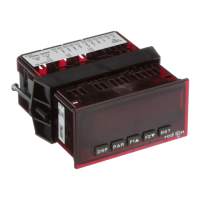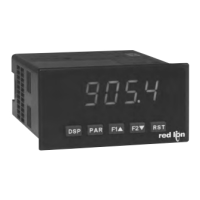9
The Security Code determines the programming mode and the accessibility
of programming parameters. This code can be used along with the Program
Mode Lock-out (
) in the User Input Function parameter (Module 1).
Two programming modes are available. Full Programming mode allows all
parameters to be viewed and modified. Quick Programming mode permits only
the Setpoint values to be modified, but allows direct access to these values
without having to enter Full Programming mode.
Programming a Security Code other than 0, requires this code to be entered
at the prompt in order to access Full Programming mode. Depending on
the code value, Quick Programming may be accessible before the prompt
appears (see chart).
PROGRAMMING SECURITY CODE
to
USER INPUT
FUNCTION
USER INPUT
STATE
SECURITY
CODE
MODE WHEN “PAR”
BUTTON IS PRESSED
FULL PROGRAMMING
MODE ACCESS
0
Full Programming Immediate Access
not
______
1-99
Quick Programming
After Quick Programming
with correct code entry
at
prompt *
100-999
prompt
With correct code entry
at
prompt *
0
Programming Lock No Access
Active
1-99
Quick Programming No Access
100-999
prompt
With correct code entry
at
prompt *
Not Active 0-999
Full Programming Immediate Access
5.4 MODULE 4 - SETPOINT OUTPUT PARAMETERS ()
PAR
Pro
Enb-n
Setpoint
Action
Setpoint
Select
Setpoint
Value
Output Reset
Action
Hysteresis
Value
Off Time
Delay
On Time
Delay
Output Reset
W/Display
Reset
SPSEL
4-SPt
Act-n SPt-n HYS-n tON-n tOF-n rSt-n rEn-n
Standby
Operation
Stb-n
Setpoint
Enable
PARAMETER MENU
OUTPUT
STATE
OFF
ON
Hys
SP + Hys
SP
OFF
TRIGGER POINTS
Low Acting (Unbalanced Hys) =
OUTPUT
STATE
OFF
ON
Hys
SP
SP - Hys
OFF
TRIGGER POINTS
High Acting (Unbalanced Hys) =
Enter the setpoint (output) to be programmed. The in the following
parameters will reflect the chosen setpoint number. After the chosen setpoint
is completely programmed, the display will return to . Repeat steps for
each setpoint to be programmed. Select to exit the module.
SETPOINT SELECT
Select to enable Setpoint and access the setup parameters. If is
selected, the unit returns to
and Setpoint is disabled.
SETPOINT ENABLE
Enter the action for the selected setpoint (output). See Setpoint Output
Figures for a visual detail of each action.
SETPOINT ACTION
High Acting, with balanced hysteresis
Low Acting, with balanced hysteresis
High Acting, with unbalanced hysteresis
Low Acting, with unbalanced hysteresis
=
=
=
=
OUTPUT
STATE
OFF
ON
Hys
SP + ½Hys
SP
SP - ½Hys
OFF
TRIGGER POINTS
High Acting (Balanced Hys) =
OUTPUT
STATE
OFF
ON
Hys
SP + ½Hys
SP
SP - ½Hys
OFF
TRIGGER POINTS
Low Acting (Balanced Hys) =
SETPOINT VALUE
Enter the desired setpoint value. The decimal point position for the setpoint
and hysteresis values follow the selection set in Module 1.
to
HYSTERESIS VALUE
to
Enter desired hysteresis value. See Setpoint Output Figures for visual
explanation of how setpoint output actions (balanced and unbalanced) are
affected by the hysteresis. When the setpoint is a control output, usually
balanced hysteresis is used. For alarm applications, usually unbalanced
hysteresis is used. For unbalanced hysteresis modes, the hysteresis functions on
the low side for high acting setpoints and functions on the high side for low
acting setpoints.
Note: Hysteresis eliminates output chatter at the switch point, while time delay
can be used to prevent false triggering during process transient events.

